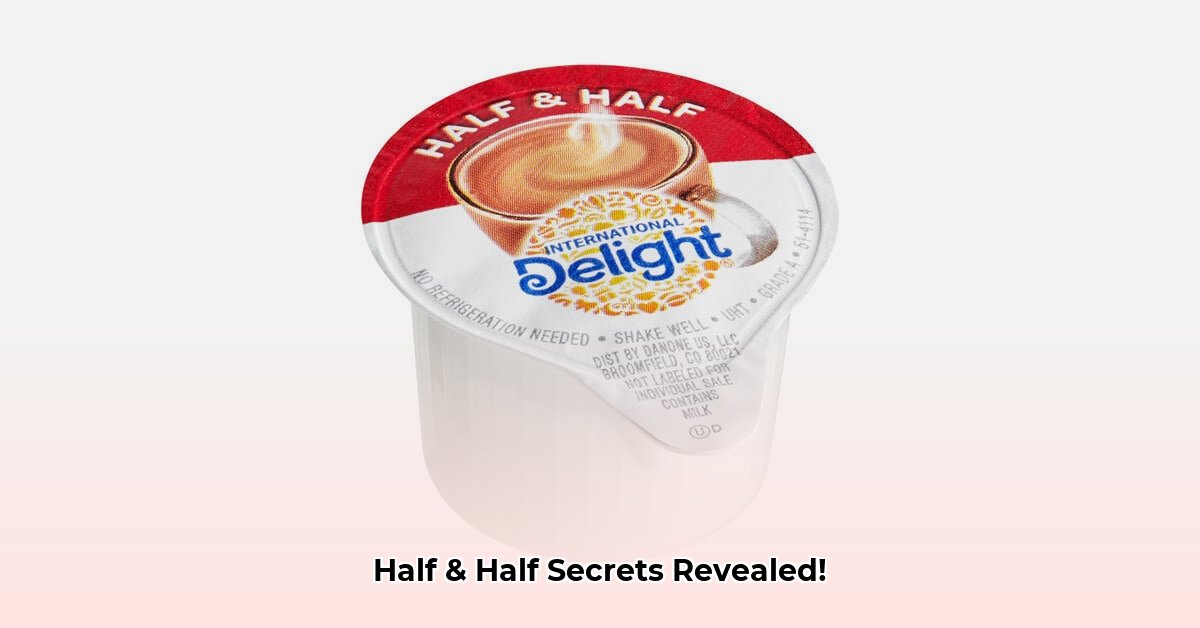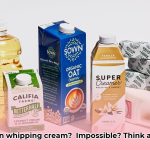Ever stand in the dairy aisle, overwhelmed by all the creamy choices? This guide cuts through the confusion and helps you understand half-and-half, coffee creamers, and heavy cream. We’ll break down the differences, compare nutritional information, and show you how to pick the perfect addition for your coffee or recipes. Whether you’re a dairy devotee, exploring plant-based options, or looking for the richest cream for cooking, we’ll empower you to make informed choices and upgrade your coffee (and cooking!) game. We’ll cover everything from the basics of what makes each product different to expert tips for getting the creamiest, tastiest results every time. Get ready to become a cream and creamer connoisseur! For dairy-free heavy cream alternatives, check out this helpful guide: [dairy-free heavy cream](https://mearnes.com/heavy-whipping-cream-dairy-free/)
Half and Half: Your Gateway to Creamy Goodness
Let’s dive into the creamy world of half-and-half! What exactly is it, and why is it so popular? Simply put, it’s a blend – half milk, half cream – creating a richer, creamier texture and taste than regular milk, but lighter than heavy cream. Perfect for your morning coffee, of course, but it’s surprisingly versatile in the kitchen too, lending itself beautifully to both sweet and savory dishes. Before you grab a carton, let’s explore what makes it tick, how it stacks up against other options, and how to best use it. Let’s unveil the secrets of this dairy staple.
Half-and-Half vs. Coffee Creamers vs. Heavy Cream: Understanding the Differences
The dairy aisle can feel like a maze. You see half-and-half, a rainbow of coffee creamers, and cartons of heavy cream. What’s the big deal? The core difference lies in the ingredients, fat content, and how they’re processed. Half-and-half is straightforward: milk and cream, that’s it. Coffee creamers, however, often contain a much longer list of ingredients, including added sugars, vegetable oils, stabilizers, and artificial flavors designed to enhance taste and shelf life. Many coffee creamers are non-dairy, using plant-based milks such as almond, soy, or oat milk as their base, often with similar additives. Heavy cream, also known as heavy whipping cream, is the thickest and richest of the three, containing a high percentage of milk fat and typically used for whipping or adding richness to sauces. So, in this creamy showdown, what are the key differentiators?
Nutritional Breakdown: Calories, Fat, and Sugar – A Comparative Look
Let’s talk numbers. A typical tablespoon of half-and-half contains roughly 20 calories and around 1.7 grams of fat. This is largely due to the natural fat content of cream. Coffee creamers can vary wildly. While some might have similar calorie counts as half-and-half, many contain significantly more added sugar – sometimes up to 5 grams per tablespoon, or even more! Heavy cream is the most calorie-dense, with approximately 51 calories and 5.4 grams of fat per tablespoon. So, is that extra sweetness or richness worth it? That’s a question only you can answer, considering your own dietary goals.
Ingredient Spotlight: What’s Really Inside Your Creamer?
The beauty of half-and-half lies in its simplicity. It’s predominantly milk and cream. Some brands might add a touch of carrageenan, a natural food additive derived from seaweed that helps to improve the texture and consistency. Coffee creamers, as we’ve discussed, usually contain a more complex blend of ingredients – water, various sugars (including corn syrup and dextrose), hydrogenated vegetable oils, and stabilizers to keep everything mixed and appealing. Plant-based alternatives swap dairy milk for plant-based options but might use similar additives to achieve a creamy texture and prolong shelf-life, so checking those labels is crucial. Heavy cream typically contains only cream, though some manufacturers may add thickeners like gellan gum to improve its consistency.
Choosing Your Perfect Cream: A Personalized Guide
Picking the right cream or creamer depends entirely on your individual needs and preferences. Consider these factors:
- Dietary restrictions: Are you lactose intolerant, following a vegan diet, or managing your cholesterol? This will greatly impact your choices. Lactose-free options are available in both dairy and non-dairy forms, vegan choices will usually land you firmly in the ‘coffee creamer’ category, and those watching cholesterol may wish to limit their intake of heavy cream.
- Health consciousness: Keeping an eye on sugar or fat intake? Scrutinize those nutrition labels! Some coffee creamers boast “low-fat” or “sugar-free” options, but read the details carefully – they may contain artificial sweeteners or other additives.
- Taste preferences: Do you prefer a simple, clean, dairy flavor, or are you looking for something sweeter, perhaps even with vanilla, chocolate, or other artificial flavors? Do you want the intense richness that heavy cream provides?
- Intended Use: Are you primarily using the cream for coffee, or do you need something versatile for cooking and baking? Heavy cream is ideal for whipping and thickening sauces, while half-and-half works well in coffee and some lighter recipes.
Here’s a handy table summarizing the key differences:
| Feature | Half-and-Half | Coffee Creamers | Heavy Cream |
|---|---|---|---|
| Main Ingredients | Milk, cream | Highly variable (water, oils, sugars, etc.) | Cream, sometimes with thickeners |
| Fat Content | Moderate (10.5-18% milkfat) | Varies greatly; often lower | High (at least 36% milkfat) |
| Sugar Content | Naturally occurring (low) | Often significantly higher (added sugars) | Naturally occurring (low) |
| Nutritional Value | Some calcium and potassium | Highly variable; usually lower overall | Some calcium and fat-soluble vitamins |
| Uses | Coffee, light sauces, some baking | Coffee, flavoring beverages | Whipping, thickening sauces, rich baking |
Beyond Coffee: Unlocking Culinary Versatility
Don’t just limit half-and-half to your coffee! Its richness adds a delightful creaminess to soups, sauces, scrambled eggs, and even baked goods. That fat content, compared to regular milk, creates a smooth texture that many recipes benefit from. Heavy cream, with its higher fat content, can be whipped into a stable topping for desserts, used to make rich sauces like Alfredo, or added to soups for a velvety texture. Experiment and see what creamy wonders you can create!
The Final Scoop: Making Informed Decisions
Ultimately, the “best” cream or creamer is subjective. It’s about finding the perfect balance between taste, nutritional goals, dietary requirements, and intended use. By carefully reading labels, comparing ingredients, and understanding the differences between half-and-half, coffee creamers, and heavy cream, you’ll be well-equipped to make the choice that best suits your needs and preferences. Happy creaming!
How to Choose the Healthiest Coffee Creamer for Lactose Intolerance: A Comprehensive Guide
Let’s face it: coffee’s often better with something creamy. But if you’re lactose intolerant, navigating the world of coffee creamers can feel like a minefield. This guide cuts through the confusion, helping you find the perfect dairy-free delight for your coffee, without sacrificing taste or health.
Understanding Your Dairy-Free Options
Dairy-free creamers come in a dizzying array of choices. Soy, almond, oat, coconut, cashew – the list goes on! Each has unique properties affecting both taste and health profile. Don’t just grab the first one you see; let’s explore what makes a creamer truly healthy for you. Even within each type (e.g., almond creamer), brands can vary significantly in ingredients and nutritional value.
Decoding the Labels: What to Look For on Dairy-Free Creamers
Choosing wisely involves careful label reading. Here’s what to scrutinize:
- Added Sugars: Many creamers pack in surprising amounts of added sugar. Excess sugar contributes to weight gain, blood sugar spikes, and other health problems. Opt for unsweetened or low-sugar varieties.
- Saturated Fat: While some fat is necessary, high saturated fat intake is associated with increased risk of heart disease. Coconut creamers, in particular, tend to be high in saturated fat. Check the label; lower is generally better.
- Ingredients List: Look for creamers with minimal processing and recognizable ingredients. Avoid long lists of unfamiliar chemicals, artificial flavors, or additives like carrageenan (a potential gut irritant for some). The fewer the ingredients, the better, generally speaking.
- Allergens: Are you allergic to nuts, soy, or coconut? Check the label very carefully to ensure you avoid potential triggers. This is crucial for your safety!
- Fortification: Some creamers are fortified with vitamins and minerals like calcium, vitamin D, and vitamin B12. This can be a benefit, especially if you don’t consume dairy.
Navigating the Nutritional Maze: Key Considerations
Nutritional information is key. Consider these factors when comparing dairy-free creamers:
- Calories: Creamers vary widely in caloric content. Choose a creamer that aligns with your overall dietary needs and goals.
- Protein: Some plant-based creamers (especially soy) offer a decent protein boost.
- Vitamins and Minerals:
- Achieve Anesthesiology Work-Life Balance: Your Guide - December 4, 2025
- Unlock Young Doctors’ Work-Life Balance: Actionable Strategies Now - December 2, 2025
- Unlock Life Harmony: Work-Life Integration Guide - November 30, 2025
















